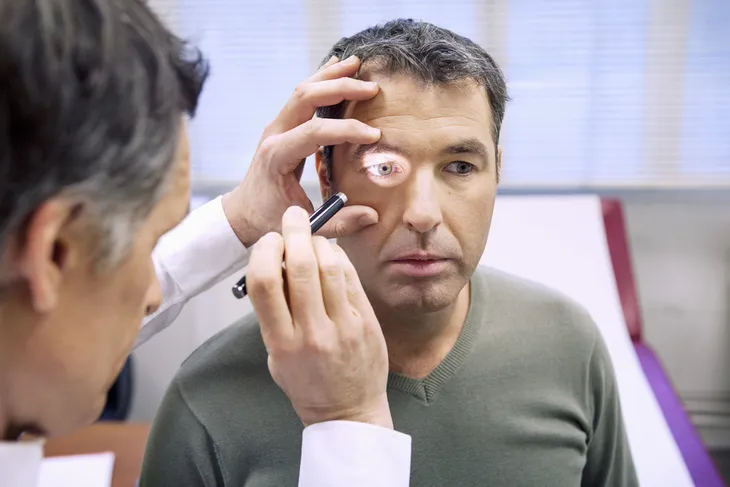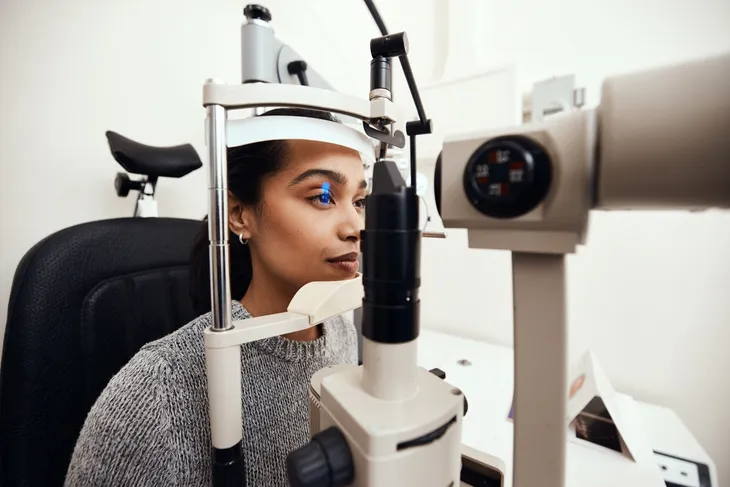- The most common type of eye cancer is intraocular melanoma but there are other types to be aware of.
- Individuals don’t develop symptoms until the tumor is more advanced, however, there are some signs to be on the lookout for such as loss of vision or floaters.
- Like other types of cancer, early intervention is key!
Eye cancer refers to any cancer that starts in the eye. The most common type of eye cancer is intraocular melanoma but even this type is pretty rare. Even though eye cancer cases are rare, they do still happen which is why you should know the signs and what you can do to prevent it.
The American Cancer Society estimates that the 5-year survival rate for localized eye melanoma is about 84-percent, however, if the cancer spreads, the survival rate drops to 18-percent. This is why early intervention is key! Here’s what you need to know about eye cancer, including the different types, common symptoms, and treatment options.
Types of Eye Cancer
Intraocular melanoma is the most common type of eye cancer, however, there are other types to be aware of too. First, it’s important to have an understanding of the parts of the eye.
The American Cancer Society says the eye is made up of 3 major parts starting with the eyeball, which contains 3 main layers (sclera, uvea, and retina). The second part is the orbit, which is the tissue that surrounds the eyeball and the third part is the adnexal structures, such as the eyelids and tear glands. The different types of cancer can develop in each of these areas. So, what are they? Let’s take a look at the different types, next!
Intraocular Melanoma
As mentioned, intraocular melanoma is the most common type of eye cancer, although it is still rare. Melanoma more commonly develops in the skin, instead of the eye but it is still possible.
The American Cancer Society explains that melanoma develops from “pigment-making cells called melanocytes.” When it develops in the eye, it usually develops in the uvea, known as uveal melanomas. It rarely develops in the conjunctiva.
The uvea is the middle layer of the eyeball and consists of 3 main parts: the iris, choroid, and ciliary body. The source says 9 out of 10 intraocular melanoma cases develop in the choroid or ciliary body. According to the source, this type of eye cancer can spread to other areas of the body through the blood and it commonly spreads to the liver.
Conjunctival Melanomas
Another type of eye cancer is known as conjunctival melanoma. The conjunctiva is “a thin clear covering over the sclera,” which is the white covering over most of the outside of the eye, explains the American Cancer Society.
Conjunctival melanoma is extremely rare and it is usually more aggressive, spreading to nearby areas. Since it can spread through the lymph system and the blood, it’s possible for the cancer to also spread to distant organs, such as the brain, lungs, or liver. If this occurs, the cancer can become life-threatening.
Orbital and Adnexal Cancers
Orbital cancer is another type worth knowing. This type of eye cancer develops in the orbit, which are the tissues that surround the eyeball, such as the muscles that help move your eye.
Cancer can also develop in the adnexal structures, such as your eyelids and tear glands. The American Cancer Society explains, “Cancers of the orbit and adnexa develop from tissues such as muscle, nerve, and skin around the eyeball and are like cancers in other parts of the body.”
Signs and Symptoms of Eye Cancer
Now that you know the different types of eye cancer, it’s vital that you know the signs so you can see a doctor as soon as you spot them. Medical News Today points out that often, individuals don’t develop symptoms until the tumor is more advanced, however, there are some signs to be on the lookout for.
For starters, blurry vision or sudden loss of vision may be a sign of eye cancer. As can floaters (spots or squiggles that move in your field of vision) and visual field loss. You should also be on the lookout for a growing dark spot on the iris and a change in the size or shape of the pupil. The source also notes that a bulging eye or an eyeball that changes position or changes in the way it moves can also be signs of cancer. Pain is less common unless the tumor is very large.
It’s important to note that these symptoms don’t always mean you have cancer and they can be signs of other conditions. Nonetheless, it’s important to notify your doctor of any abnormal symptoms to find out the root cause.
What Causes Eye Cancer?
Unfortunately, the American Cancer Society says the exact cause of most eye cancers isn’t known. However, experts have linked eye cancer to some other conditions, which we’ll dive into next.
The source also notes that scientists are exploring how certain changes in DNA can cause cells to become cancerous. Some genes, known as oncogenes, help cells grow, divide, or stay alive. Another type is known as tumor suppressor genes, which slow down cell division or cause cells to expire. “Cancers can be caused by DNA changes that turn on oncogenes or turn off tumor suppressor genes,” explains the source.
Possible Risk Factors
Although the exact cause of eye cancer is unknown, the American Cancer Society says some factors may increase your risk. However, it’s important to note that just because you have one or several of these risk factors, doesn’t guarantee that you’ll develop eye cancer. If you’re concerned about your risk, talk to your doctor. The source notes the following as possible risk factors for eye cancer:
- Race: eye melanoma is more common in white individuals than in people of color.
- Eye color: uveal melanoma is more common in individuals with light-colored eyes.
- Age and gender: though anyone can develop eye melanoma, the risk is greater as you grow older and it’s slightly more common in men.
- Certain inherited conditions: having conditions like oculodermal melanocytosis, dysplastic nevus syndrome, and BAP1 cancer syndrome may increase your risk.
- Moles or freckles: individuals with different types of moles or freckles may have an increased risk of eye cancer.
- Family history: having an immediate family member with eye cancer may increase your risk.
Diagnosing Eye Cancer
If you notice signs of eye cancer or are worried about your risk, talk to your doctor. To diagnose eye cancer, your doctor will likely refer you to a doctor who specializes in eye diseases, known as an ophthalmologist. The specialist will review your medical history and perform an eye exam.
If eye cancer is suspected during the eye exam, further testing may be necessary to confirm a diagnosis. The American Cancer Society says imaging tests such as ultrasound or optical coherence tomography (OCT) may be necessary. Your specialist may also require a magnetic resonance imaging (MRI) scan or a computed tomography (CT) scan.
Eye melanomas can usually be detected through eye exams and imaging tests, however, other types may require a biopsy. This involves removing a small piece of the tumor to examine it for cancer cells.
How Is Eye Cancer Treated?
Before deciding on the best course of treatment, Medical News Today says your doctor will need to first determine the size of the tumor and whether the cancer has spread to other parts of the body. This process is called staging.
The source notes that some eye cancers are curable while others aren’t treatable, however, some treatments may help prevent the cancer from spreading or getting worse. So, how is eye cancer treated, exactly? Treatment may include surgery, chemotherapy, as well as other strategies, which we will dive into next.
 novak.elcic / Shutterstock
novak.elcic / ShutterstockSurgery
Surgery may be the first course of treatment. However, Medical News Today notes that the “type and extent of surgery will depend on the location and size of the tumor.”
In some cases, only a small amount of tissue will need to be removed. In more severe cases, complete removal of the eyeball, known as enucleation, may be necessary. It’s also important to note that surgery may lead to loss of some or all vision in the eye.
Other Treatment Options
Other types of treatment options include radiation therapy, laser therapy, or chemotherapy. Radiation uses high-energy X-ray beams to help treat the cancer. This treatment option is usually more common than surgery because it can preserve vision, explains Medical News Today.
Laser therapy uses infrared light to heat and destroy the tumor. Even though chemotherapy is an option, the source notes it’s not usually the first treatment option for eye cancer unless it has spread. Ultimately, your doctor will determine which course of treatment is best for your eye cancer.
Can Eye Cancer Be Prevented?
Since the exact cause isn’t known, there is also no certain way to prevent eye cancer. That said, the American Cancer Society says we do know that there is a link between sunlight and melanomas. So, you can take steps to reduce your risk of these types of cancer.
To protect your skin and eyes, limit your exposure to sunlight and wear protective clothing including hats. The source also recommends wearing UV-protected sunglasses, especially wrap-around sunglasses with 99- to 100-percent UVA and UVB absorption to protect your eyes and surrounding skin. Improving your overall health is important too. Medical News Today says some ways you can do this are by not smoking or quitting smoking, eating a healthy diet, exercising regularly, and maintaining a healthy weight.














